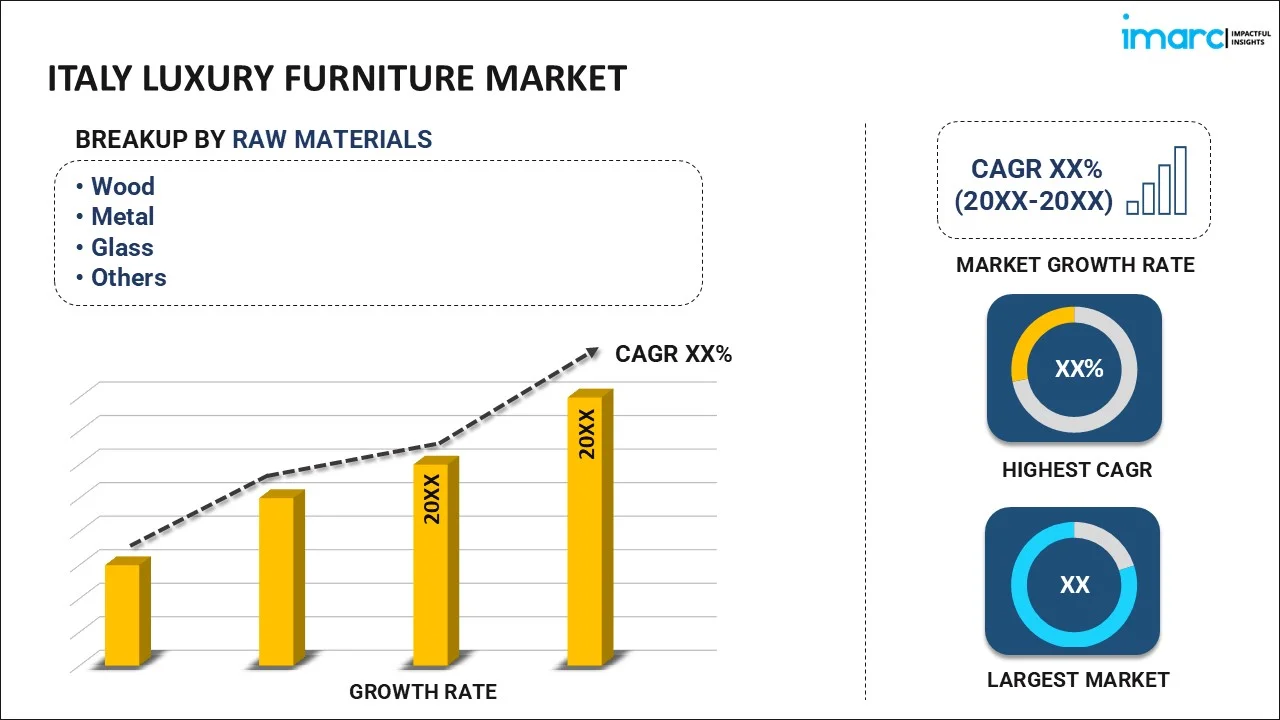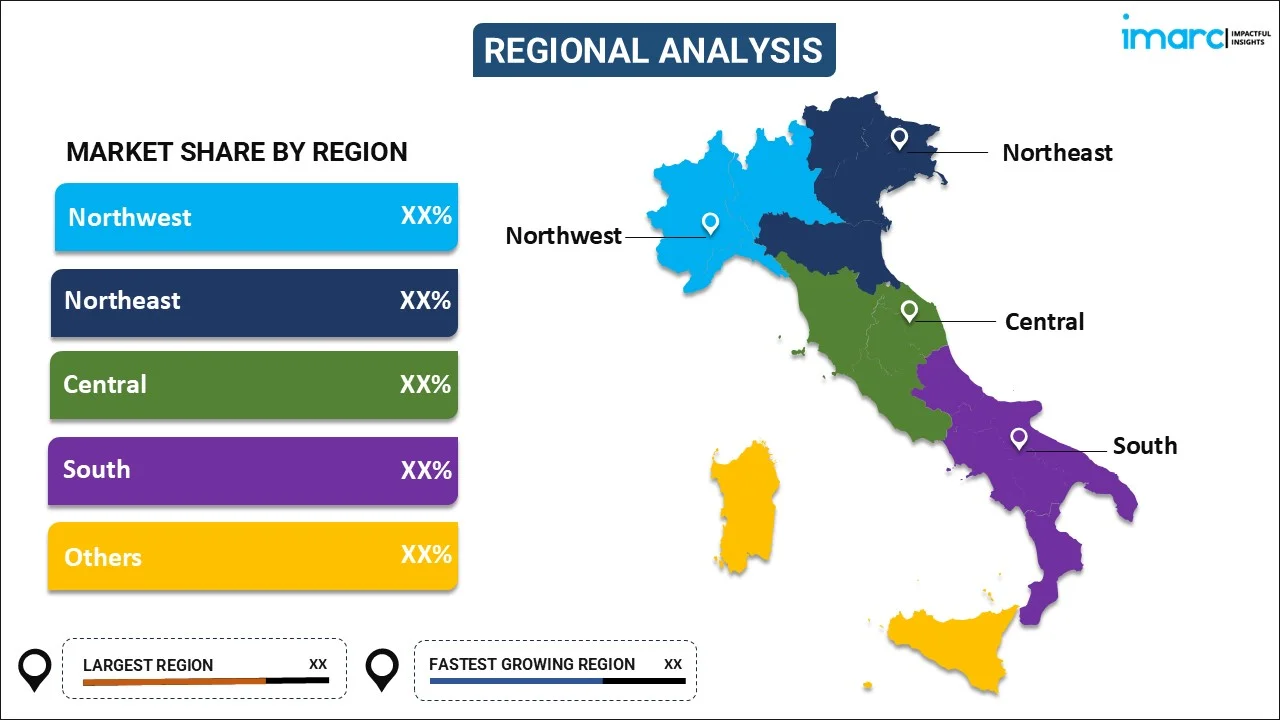
Italy Luxury Furniture Market Size, Share, Trends and Forecast by Raw Material, Application, Distribution Channel, Design, and Region, 2025-2033
Italy Luxury Furniture Market Overview:
The Italy luxury furniture market size reached USD 719.10 Million in 2024. Looking forward, IMARC Group expects the market to reach USD 1,079.43 Million by 2033, exhibiting a growth rate (CAGR) of 4.28% during 2025-2033. Rising demand for high-end home décor, increasing disposable incomes, growth in real estate and hospitality sectors, preference for artisanal craftsmanship, sustainability trends, expanding e-commerce, and strong exports of Italian luxury brands are driving the growth of the Italy luxury furniture market.
|
Report Attribute
|
Key Statistics
|
|---|---|
|
Base Year
|
2024 |
|
Forecast Years
|
2025-2033
|
|
Historical Years
|
2019-2024
|
| Market Size in 2024 | USD 719.10 Million |
| Market Forecast in 2033 | USD 1,079.43 Million |
| Market Growth Rate (2025-2033) | 4.28% |
Italy Luxury Furniture Market Trends:
Emphasis on Sustainability and Eco-Friendly Materials
The Italian luxury furniture industry is rapidly emphasizing sustainability as both manufacturers and consumers look toward environmental friendly products and processes. This is all being spurred by increased environmental sensitivity and a push for sustainable luxury. Much of this growth stems from the surging demand for sustainable products. According to a 2023 survey, 68% of Italian customers identify environmental concerns as an essential aspect of buying decisions for luxury furniture. Additionally, manufacturers are incorporating more eco-friendly materials like reclaimed wood, bamboo, and recycled metal. In 2023, 45% of luxury furniture companies in Italy used at least one type of environment-friendly material in their lines, demonstrating an intent to minimize environmental footprints. Additionally, certifications like the Forest Stewardship Council (FSC) and the Programme for the Endorsement of Forest Certification (PEFC) are now widely adopted. In 2024, 52% of luxury furniture items in the Italian market carried such certifications, giving consumers the guarantee of sustainable sourcing and production methods.
Integration of Technology and Digital Innovation
The combination of technology with conventional craftsmanship is transforming the Italian luxury furniture sector. Companies are adopting digital technology and intelligent features to drive design, manufacturing, and customer interactions. The expansion is spurred by digital platforms providing bespoke shopping experiences and virtual showrooms, bringing luxury furniture within reach for a wider group of consumers. Ongoing product innovation, for example, integrating technology into furniture design, has resulted in the creation of smart luxury furniture, providing a good prognosis for market growth. For example, in January 2021, Scavolini introduced the first Alexa-integrated kitchen, bathroom, and living room furniture, enabling users to control different functions using voice commands. This fusion of smart elements addresses the modern consumer's need for convenience and innovation. Apart from this, new manufacturing technologies like 3D printing and CNC machining are being implemented to attain precision and customization in luxury furniture. By 2023, 35% of Italian luxury furniture producers had incorporated digital fabrication techniques into their production, which increased efficiency and enabled complex designs that were difficult to make earlier.
Italy Luxury Furniture Market Segmentation:
IMARC Group provides an analysis of the key trends in each segment of the market, along with forecasts at the region/country level for 2025-2033. Our report has categorized the market based on raw material, application, distribution channel, and design.
Raw Material Insights:

- Wood
- Metal
- Glass
- Leather
- Plastic
- Multiple
- Others
The report has provided a detailed breakup and analysis of the market based on the raw material. This includes wood, metal, glass, leather, plastic, multiple, and others.
Application Insights:
- Domestic
- Living Room and Bedroom
- Kitchen
- Bathroom
- Outdoor
- Lighting
- Commercial
- Office
- Hospitality
- Others
A detailed breakup and analysis of the market based on the application have also been provided in the report. This includes domestic (living room and bedroom, kitchen, bathroom, outdoor, and lighting) and commercial (office, hospitality, and others).
Distribution Channel Insights:
- Conventional Furniture Stores
- Specialty Stores
- Online Retailers
- Others
The report has provided a detailed breakup and analysis of the market based on the distribution channel. This includes conventional furniture stores, specialty stores, online retailers, and others.
Design Insights:
- Modern
- Contemporary
A detailed breakup and analysis of the market based on the design have also been provided in the report. This includes modern and contemporary.
Regional Insights:

- Northwest
- Northeast
- Central
- South
- Others
The report has also provided a comprehensive analysis of all the major regional markets, which include Northwest, Northeast, Central, South, and others.
Competitive Landscape:
The market research report has also provided a comprehensive analysis of the competitive landscape. Competitive analysis such as market structure, key player positioning, top winning strategies, competitive dashboard, and company evaluation quadrant has been covered in the report. Also, detailed profiles of all major companies have been provided.
Italy Luxury Furniture Market News:
- November 2024: The world's first Café Ginori has opened in Florence, showcasing Italian design. The prestigious porcelain brand, Ginori 1735, has partnered with St. Regis Hotels & Resorts, a luxury hotel chain founded in 1904. The café aims to return to its roots at the St. Regis in Florence, showcasing timeless Italian beauty values.
- September 2024: The Milan furniture fair unveiled iconic designs from around the world, including the Tala Verde 2024 vase by Ronan Bouroullec for Mutina, the Emili armchair by Hannes Peer for Minotti, the Ernest armchair and pouffe by Jean-Marie Massaud for Poliform, the SuperWire floor lamp by Formafantasma for Flos, etc.
Italy Luxury Furniture Market Report Coverage:
| Report Features | Details |
|---|---|
| Base Year of the Analysis | 2024 |
| Historical Period | 2019-2024 |
| Forecast Period | 2025-2033 |
| Units | Million USD |
| Scope of the Report |
Exploration of Historical Trends and Market Outlook, Industry Catalysts and Challenges, Segment-Wise Historical and Future Market Assessment:
|
| Raw Materials Covered | Wood, Metal, Glass, Leather, Plastic, Multiple, Others |
| Applications Covered |
|
| Distribution Channels Covered | Conventional Furniture Stores, Specialty Stores, Online Retailers, Others |
| Designs Covered | Modern, Contemporary |
| Regions Covered | Northwest, Northeast, Central, South, Others |
| Customization Scope | 10% Free Customization |
| Post-Sale Analyst Support | 10-12 Weeks |
| Delivery Format | PDF and Excel through Email (We can also provide the editable version of the report in PPT/Word format on special request) |
Key Questions Answered in This Report:
- How has the Italy luxury furniture market performed so far and how will it perform in the coming years?
- What is the breakup of the Italy luxury furniture market on the basis of raw material?
- What is the breakup of the Italy luxury furniture market on the basis of application?
- What is the breakup of the Italy luxury furniture market on the basis of distribution channel?
- What is the breakup of the Italy luxury furniture market on the basis of design?
- What are the various stages in the value chain of the Italy luxury furniture market?
- What are the key driving factors and challenges in the Italy luxury furniture market?
- What is the structure of the Italy luxury furniture market and who are the key players?
- What is the degree of competition in the Italy luxury furniture market?
Key Benefits for Stakeholders:
- IMARC’s industry report offers a comprehensive quantitative analysis of various market segments, historical and current market trends, market forecasts, and dynamics of the Italy luxury furniture market from 2019-2033.
- The research report provides the latest information on the market drivers, challenges, and opportunities in the Italy luxury furniture market.
- Porter's five forces analysis assist stakeholders in assessing the impact of new entrants, competitive rivalry, supplier power, buyer power, and the threat of substitution. It helps stakeholders to analyze the level of competition within the Italy luxury furniture industry and its attractiveness.
- Competitive landscape allows stakeholders to understand their competitive environment and provides an insight into the current positions of key players in the market.
Need more help?
- Speak to our experienced analysts for insights on the current market scenarios.
- Include additional segments and countries to customize the report as per your requirement.
- Gain an unparalleled competitive advantage in your domain by understanding how to utilize the report and positively impacting your operations and revenue.
- For further assistance, please connect with our analysts.
 Request Customization
Request Customization
 Speak to an Analyst
Speak to an Analyst
 Request Brochure
Request Brochure
 Inquire Before Buying
Inquire Before Buying




.webp)




.webp)












